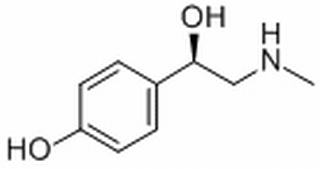Home
Products
Synephrine



| Product Name | Synephrine |
| Price: | Inquiry |
| Catalog No.: | CN02188 |
| CAS No.: | 94-07-5 |
| Molecular Formula: | C9H13NO2 |
| Molecular Weight: | 167.21 g/mol |
| Purity: | >=98% |
| Type of Compound: | Alkaloids |
| Physical Desc.: | White powder |
| Source: | The young fruits Citrus aurantium L. |
| Solvent: | Chloroform, Dichloromethane, Ethyl Acetate, DMSO, Acetone, etc. |
| SMILES: |
| Contact us | |
|---|---|
| First Name: | |
| Last Name: | |
| E-mail: | |
| Question: | |
| Description | Synephrine (Oxedrine) is an α-adrenergic and β-adrenergic agonist derived from the Citrus aurantium, it has sympathomimetic and structural similarities to ephedra and ephedrine alkaloids[1][2]. |
| Target | α-adrenergic and β-adrenergic[1] |
| In Vivo | Synephrine (1 mg/kg; oral gavage; for 8 days; PVL and BDL rats) significantly ameliorates the hyperdynamic state in both PVL and BDL rats. The portal venous pressure in PVL and BDL rats, portal tributary blood flow and cardiac index are significantly reduced, while mean arterial pressure and systemic as well as portal territory vascular resistance are enhanced by treatment of Synephrine[2]. Animal Model: Portal vein ligation (PVL) or bile duct ligation (BDL) rats[2] Dosage: 1 mg/kg per 12 hours Administration: Oral gavage; for 8 days Result: The portal venous pressure in PVL and BDL rats, portal tributary blood flow and cardiac index were significantly reduced, while mean arterial pressure and systemic as well as portal territory vascular resistance were enhanced. |
| Density | 1.2±0.1 g/cm3 |
| Boiling Point | 341.1±27.0 °C at 760 mmHg |
| Flash Point | 163.4±14.3 °C |
| Exact Mass | 167.094635 |
| PSA | 52.49000 |
| LogP | -0.03 |
| Vapour Pressure | 0.0±0.8 mmHg at 25°C |
| Storage condition | 2-8°C |